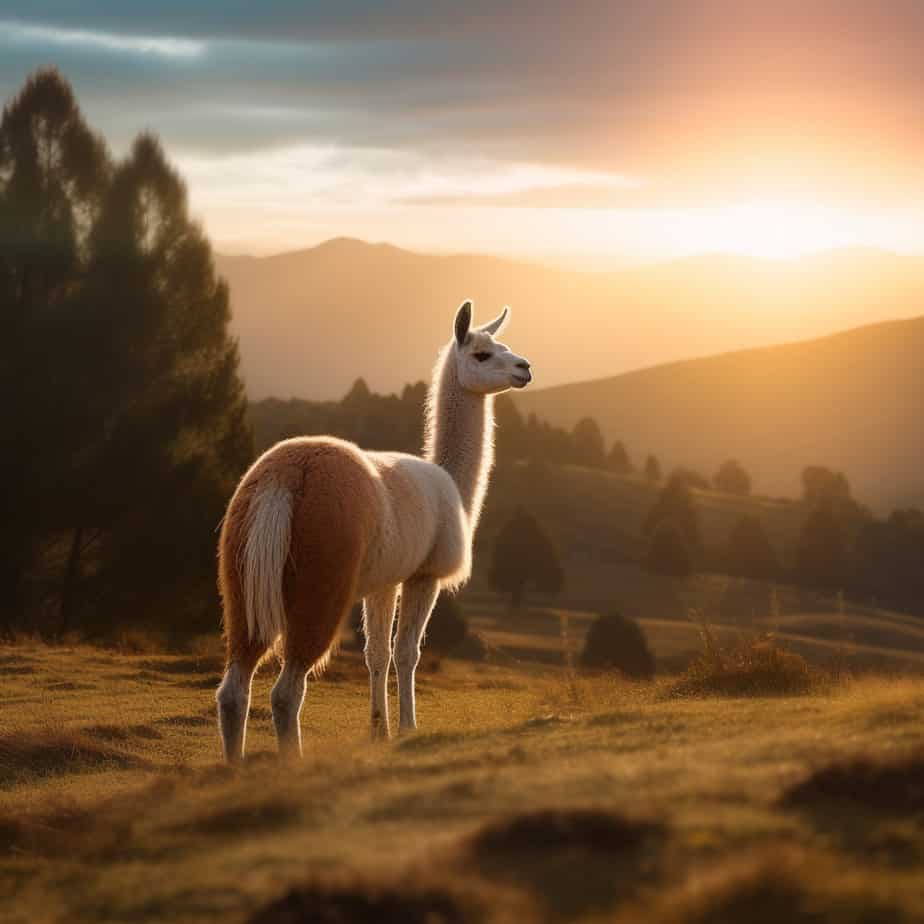Llamas, those adorable and curious creatures, have a fascinating reproductive process. If you’ve ever wondered how long llamas are pregnant, you’ve come to the right place. In this article, we will explore the gestation period of llamas, shedding light on the duration of their pregnancy and the various factors that can influence it. Whether you’re a llama enthusiast, a farmer, or simply curious about these majestic animals, join us as we delve into the world of llama pregnancies. So, let’s get started and discover the incredible journey of llama reproduction!
Key Takeaways
- Llamas have a gestation period of approximately 11.5 months.
- The length of a llama’s pregnancy can vary slightly, ranging from 335 to 360 days.
- It is important to monitor the pregnant llama‘s health and provide proper care during this period.
- Llamas typically give birth to a single cria (baby llama) at a time.
Understanding Llama Pregnancy: An Overview
A. The Llama Reproduction Cycle
Llamas, like many other mammals, have a reproductive cycle that involves mating, pregnancy, and giving birth. Understanding the llama reproduction cycle is essential for llama owners and breeders to ensure the health and well-being of their animals.
Mating
The mating season for llamas typically occurs during the spring and summer months. During this time, female llamas, known as dams, become receptive to mating. Male llamas, called sires, will display courtship behaviors such as neck wrestling and humming to attract the attention of the dams.
Once a pair has successfully mated, the female llama will undergo a process called ovulation induction. This means that the act of mating triggers the release of an egg from the dam’s ovary, increasing the chances of fertilization.
Pregnancy
After successful mating, the female llama enters the gestation period, which refers to the time between fertilization and birth. Llama pregnancy typically lasts for around 11.5 months, although it can range from 335 to 360 days. This extended pregnancy duration is one of the longest among domesticated mammals.
During pregnancy, the dam’s body undergoes various changes to support the growing fetus. It is crucial for llama owners to provide proper prenatal care, including a balanced diet, regular veterinary check-ups, and appropriate exercise, to ensure the health of both the dam and the developing cria (baby llama).
Giving Birth
As the end of the gestation period approaches, the dam will exhibit signs of impending labor. These signs may include restlessness, pacing, and frequent lying down and getting up. Llama owners should closely monitor the dam during this time and provide a clean and comfortable birthing area.
Llama births, also known as parturition, are typically smooth and uncomplicated. The dam will usually give birth while standing or lying down, and the cria will emerge within an hour or two. It is essential to allow the dam and cria to bond naturally and provide them with a quiet and stress-free environment.
B. The Significance of Llama Pregnancy Length
The length of llama pregnancy is significant for both llama owners and veterinarians. Understanding the average duration of llama pregnancy helps in determining the expected due date and planning for the care of the dam and cria.
While the average llama pregnancy lasts around 11.5 months, it is important to note that individual variations can occur. Factors such as genetics, nutrition, and overall health can influence the length of pregnancy. Llama owners should keep track of the mating dates and consult with a veterinarian to ensure accurate estimation of the due date.
Knowing the expected due date allows llama owners to prepare for the birthing process and provide appropriate prenatal care. It also helps in identifying any potential complications or deviations from the normal pregnancy timeline. Regular veterinary check-ups during pregnancy can help monitor the dam’s health and ensure the well-being of both the dam and the cria.
In conclusion, understanding the llama reproduction cycle and the length of llama pregnancy is essential for llama owners and breeders. By providing proper care and monitoring, they can ensure the health and well-being of their llamas throughout the entire reproductive process.
The Duration of Llama Pregnancy: A Detailed Analysis
A. How Long is a Llama Pregnant in Days?
Llamas, like many other mammals, have a gestation period, which is the time it takes for the fetus to develop inside the mother‘s womb. The average duration of llama pregnancy is around 335 to 360 days, which is approximately 11 to 12 months. However, it’s important to note that the length of pregnancy can vary slightly from one llama to another. Some llamas may give birth a few days earlier or later than the average timeframe.
During this period, the female llama undergoes significant changes to support the growth and development of the fetus. Just like humans, llamas experience hormonal changes and physical adaptations to prepare for giving birth. It’s crucial for llama owners and breeders to be aware of the signs of pregnancy and provide appropriate care to ensure a healthy outcome for both the mother and the baby.
B. Factors Influencing Llama Pregnancy Length
While the average duration of llama pregnancy is around 335 to 360 days, several factors can influence the length of pregnancy in llamas. These factors include:
-
Genetics: The genetic makeup of the llama can play a role in determining the length of pregnancy. Some llamas may have a genetic predisposition for shorter or longer gestation periods.
-
Nutrition: Adequate nutrition is essential for a healthy pregnancy. Llamas that receive a balanced diet with proper amounts of vitamins, minerals, and protein are more likely to have a normal pregnancy length.
-
Environmental Factors: Environmental conditions, such as temperature and altitude, can impact llama pregnancy length. Extreme weather conditions or high altitudes may affect the development of the fetus and potentially prolong the pregnancy.
-
Stress Levels: Stress can have a significant impact on llama pregnancy. High levels of stress, whether due to transportation, changes in herd dynamics, or other factors, can potentially lead to a longer gestation period.
-
Breeding Practices: The timing and method of breeding can also influence the length of llama pregnancy. Accurate record-keeping of breeding dates and ensuring proper mating techniques can help estimate the expected due date more accurately.
It’s important to note that while these factors may influence the length of llama pregnancy, they are not definitive predictors. Each llama is unique, and individual variations can occur. Therefore, it’s crucial to monitor the pregnant llama closely and consult with a veterinarian for proper prenatal care and guidance.
Understanding the duration of llama pregnancy and the factors that can influence it is essential for llama owners and breeders. By providing appropriate care, nutrition, and monitoring, we can ensure a healthy pregnancy and successful birth for these magnificent animals.
The Post-Pregnancy Phase: Mother-Baby Llama Bonding

After the long-awaited arrival of a baby llama, it’s time for the mother and her newborn to establish a strong bond. This phase is crucial for the baby‘s development and overall well-being. Let’s explore how long a baby llama stays with its mother and the important role maternal care plays in their growth.
A. How Long Does a Baby Llama Stay with Its Mother?
Baby llamas, also known as crias, rely heavily on their mothers for nourishment, protection, and guidance. They form a strong bond that lasts for an extended period. Typically, crias stay with their mothers for around six to eight months. During this time, they learn essential skills and behaviors necessary for survival in their environment.
The duration of this bonding period allows the cria to develop both physically and socially. They learn to navigate their surroundings, communicate with other llamas, and establish their place within the herd. It’s a critical time for the cria to gain strength and independence while still benefiting from the care and guidance of their mother.
B. The Role of Maternal Care in Llama Development
Maternal care plays a vital role in the development of a baby llama. Llama mothers, known as dams, are attentive and nurturing, ensuring the well-being of their crias. They provide essential care and guidance that sets the foundation for the cria’s future growth.
During the early stages of bonding, the dam provides milk to her cria, which is rich in nutrients and antibodies. This milk helps the cria develop a robust immune system and provides the necessary sustenance for healthy growth. The dam also teaches the cria about grazing, showing them which plants are safe to eat and how to forage for food.
Apart from nourishment, the dam also offers protection to her cria. Llamas are known for their strong maternal instincts and will fiercely defend their young against potential threats. This protective behavior ensures the safety of the cria and allows them to explore their surroundings with confidence.
As the cria grows older, the dam gradually introduces them to the rest of the herd. This socialization process is crucial for the cria to learn proper llama etiquette and establish relationships within the group. The dam acts as a guide, teaching the cria how to interact with other llamas, communicate through body language, and establish a hierarchy.
In addition to physical care, the dam also provides emotional support to her cria. The bond between a mother and her baby llama is strong, and the dam offers comfort and reassurance during times of stress or uncertainty. This emotional connection helps the cria develop a sense of security and confidence as they navigate their world.
In conclusion, the post-pregnancy phase is a critical time for mother-baby llama bonding. The duration of this bonding period allows the cria to develop both physically and socially, while the dam provides essential care, nourishment, protection, and guidance. It is through this strong bond that baby llamas learn the skills and behaviors necessary for their growth and survival.
Common Questions about Llama Pregnancy

A. How Long Does a Llama Stay Pregnant?
One of the most common questions asked about llamas is how long their pregnancy lasts. The gestation period for llamas typically ranges from 335 to 360 days, which is approximately 11 to 12 months. However, it’s important to note that there can be some variation in the duration of pregnancy among individual llamas.
During this period, llama owners and breeders need to provide proper care and attention to ensure the health and well-being of the pregnant llama. This includes monitoring the llama’s diet, providing regular veterinary check-ups, and creating a comfortable and stress-free environment.
B. Variations in Pregnancy Duration among Different Llama Breeds
While the average gestation period for llamas falls within the 335 to 360-day range, it’s worth mentioning that there can be variations in pregnancy duration among different llama breeds. Some breeds may have slightly shorter or longer gestation periods compared to others.
For example, research has shown that Suri llamas tend to have a slightly longer gestation period compared to Huacaya llamas. Suri llamas typically have a gestation period of around 350 to 360 days, while Huacaya llamas usually have a gestation period of around 335 to 345 days.
These variations in pregnancy duration among different llama breeds highlight the importance of understanding the specific characteristics and needs of each breed. Llama owners and breeders should consult with experienced professionals or refer to breed-specific resources to ensure they are providing the appropriate care during the pregnancy period.
In conclusion, the duration of llama pregnancy typically ranges from 335 to 360 days, with some variations among different llama breeds. It is essential for llama owners and breeders to be aware of these timelines and provide the necessary care and attention to ensure a healthy pregnancy and successful birth.
The Impact of Pregnancy Length on Llama Health and Well-being

A. The Connection between Pregnancy Length and Llama Health
The length of a llama’s pregnancy, also known as the gestation period, plays a crucial role in the overall health and well-being of the animal. Understanding the duration of llama pregnancy is essential for providing proper care and ensuring a successful birth.
Llamas have a relatively long gestation period compared to other domesticated animals. On average, llama pregnancies last between 335 and 360 days, which is around 11 to 12 months. However, it’s important to note that the exact length can vary slightly from one llama to another.
During this extended period, the developing fetus undergoes significant growth and development. The length of pregnancy directly impacts the health of both the mother llama, known as the dam, and the unborn cria, the term for a baby llama.
B. The Importance of Proper Care during Llama Pregnancy
Proper care during llama pregnancy is crucial for ensuring the health and well-being of both the dam and the cria. Llamas that receive adequate prenatal care are more likely to have successful pregnancies and deliver healthy offspring.
-
Nutrition: Providing a balanced and nutritious diet is essential during llama pregnancy. The dam’s nutritional needs increase as the fetus grows, so it’s important to adjust their diet accordingly. High-quality hay, fresh water, and mineral supplements should be provided to meet their nutritional requirements.
-
Veterinary Care: Regular veterinary check-ups are vital to monitor the progress of the pregnancy and address any potential health issues. Vaccinations and deworming should be up to date to prevent any complications that could affect the dam or the cria.
-
Exercise and Rest: Llamas should be given ample space for exercise, but it’s also important to ensure they have enough rest. Overexertion during pregnancy can be detrimental to both the dam and the cria. Providing a comfortable and stress-free environment is crucial for their well-being.
-
Monitoring Signs of Pregnancy: It’s essential to be able to recognize the signs of llama pregnancy. These signs can include weight gain, changes in behavior, and physical changes such as an enlarged abdomen and udder development. Regular monitoring allows for early detection of any potential issues.
-
Preparing for Birth: As the pregnancy progresses, it’s important to prepare for the birth of the cria. Creating a clean and safe birthing area, known as a birthing pen, is essential. This area should be well-equipped with clean bedding and necessary supplies for assisting with the birth if needed.
By providing proper care and attention throughout the pregnancy, llama owners can ensure the health and well-being of both the dam and the cria. This not only contributes to a successful birth but also sets the foundation for a healthy and thriving newborn llama. Conclusion
In conclusion, llamas have a relatively long gestation period compared to other domesticated animals. On average, llamas are pregnant for around 11 months, which is approximately 335 days. However, it is important to note that this duration can vary slightly from one individual to another. Llamas are highly adaptable animals and have been successfully bred in various climates and environments. Their ability to carry their young for an extended period is a testament to their resilience and adaptability. Understanding the gestation period of llamas is crucial for llama owners and breeders to ensure the health and well-being of these magnificent creatures. So, whether you’re considering breeding llamas or simply curious about their reproductive cycle, knowing how long llamas are pregnant can provide valuable insights into their fascinating biology.
Frequently Asked Questions
Q1: What is the length of a llama pregnancy?
The length of a llama pregnancy, also known as the gestation period, typically lasts for about 11 to 12 months, or approximately 350 days.
Q2: How long does a baby llama stay with its mother?
A baby llama, or cria, usually stays with its mother for about six months to a year. During this time, the mother llama provides nourishment and protection to the cria.
Q3: What is the duration of a llama’s pregnancy?
The duration of a llama’s pregnancy is typically between 330 to 365 days, with an average of around 350 days.
Q4: How long does a llama stay pregnant?
A llama stays pregnant for approximately 11 to 12 months, or around 350 days.
Q5: How many days is a llama pregnant?
A llama is pregnant for approximately 330 to 365 days, with the average being around 350 days.
Q6: What is the llama breeding cycle?
The llama breeding cycle is not seasonally restricted like some animals. Female llamas are induced ovulators, meaning they can breed and become pregnant at any time of the year.
Q7: What are the signs of llama pregnancy?
The signs of llama pregnancy can include changes in behavior, increased appetite, weight gain, and in later stages, visible abdominal enlargement. A veterinary professional can confirm pregnancy through ultrasound or palpation.
Q8: How to care for pregnant llamas?
Caring for pregnant llamas involves providing a balanced diet, ensuring they have access to clean water, and regular veterinary check-ups. It’s also important to provide a safe and comfortable environment for the llama to give birth.
Q9: What is the llama birth process like?
The llama birth process typically occurs during daylight hours. The mother will isolate herself from the herd and the birth can take anywhere from 30 minutes to several hours. After birth, the cria should be standing and nursing within the first hour.
Q10: How to care for a newborn llama?
Newborn llama care involves ensuring the cria is nursing properly, keeping it warm and safe, and monitoring for any signs of illness. Regular veterinary check-ups are also important to ensure the cria is healthy and developing properly.




